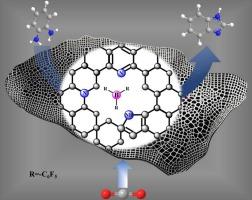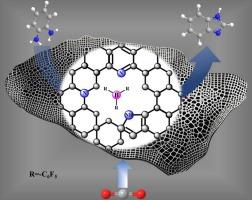Construction of frustrated Lewis pairs based on in-situ nitrogen-doped polymer-derived porous carbon for CO2 capture and conversion
IF 4.3
2区 工程技术
Q2 ENGINEERING, CHEMICAL
引用次数: 0
Abstract
The capture and conversion of CO2 into high-value fine chemicals represented one of the most promising approaches to addressing the issue of excessive carbon emissions. Frustrated Lewis pairs (FLPs) had attracted significant attention in CO2 catalytic conversion due to their non-metallic nature and high reactivity. To address the industrial requirement for recyclable catalyst performance, the development of heterogeneous FLPs tailored for CO2 conversion is of paramount importance. In this study, we first synthesized N-containing polymers using bipyridine and triphenylamine as structural units respectively, followed by a carbonization procedure to obtain in-situ N-doped porous carbon (designated as PC-BP and PC-TP, respectively). Subsequently, we introduced B(C6F5)3 into PC-BP and PC-TP to construct FLPs between B and N (named PC-BP-FLPs and PC-TP-FLPs). The PC-BP-FLPs and PC-TP-FLPs exhibited excellent CO2 capture performances, with the maximum CO2 adsorption capacities of PC-BP-FLPs and PC-TP-FLPs reached 41 cm3/g and 60 cm3/g at 273.15 K and 1 bar, respectively. And then, PC-BP-FLPs and PC-TP-FLPs demonstrated excellent catalytic conversion performance (Yield > 90 %) and recyclability (at least 5 cycles) in the process of catalyzing the synthesis benzimidazole from o-phenylenediamine and CO2. These findings indicated that the catalysts held great application potential in the field of CO2 capture and conversion, providing a sustainable solution for non-metallic catalytic conversion of CO2.


基于原位氮掺杂聚合物衍生多孔碳的受挫Lewis对的构建及其对CO2的捕获和转化
捕获二氧化碳并将其转化为高价值精细化学品是解决过度碳排放问题的最有希望的方法之一。受挫刘易斯对(FLPs)由于其非金属性质和高反应活性在CO2催化转化中引起了广泛的关注。为了满足工业对可回收催化剂性能的要求,开发适合二氧化碳转化的多相FLPs至关重要。在本研究中,我们首先分别以联吡啶和三苯胺为结构单元合成了含n聚合物,然后通过碳化工艺得到原位n掺杂多孔碳(分别命名为PC-BP和PC-TP)。随后,我们将B(C6F5)3引入PC-BP和PC-TP中,构建了B与N之间的FLPs(分别命名为PC-BP-FLPs和PC-TP-FLPs)。PC-BP-FLPs和PC-TP-FLPs表现出优异的CO2捕获性能,在273.15 K和1 bar条件下,PC-BP-FLPs和PC-TP-FLPs的最大CO2吸附量分别达到41 cm3/g和60 cm3/g。然后,PC-BP-FLPs和PC-TP-FLPs在催化邻苯二胺和CO2合成苯并咪唑的过程中表现出优异的催化转化性能(产率 >; 90 %)和可回收性(至少5次循环)。这些结果表明,该催化剂在CO2捕集与转化领域具有很大的应用潜力,为CO2的非金属催化转化提供了一种可持续的解决方案。
本文章由计算机程序翻译,如有差异,请以英文原文为准。
求助全文
约1分钟内获得全文
求助全文
来源期刊

Chemical Engineering Science
工程技术-工程:化工
CiteScore
7.50
自引率
8.50%
发文量
1025
审稿时长
50 days
期刊介绍:
Chemical engineering enables the transformation of natural resources and energy into useful products for society. It draws on and applies natural sciences, mathematics and economics, and has developed fundamental engineering science that underpins the discipline.
Chemical Engineering Science (CES) has been publishing papers on the fundamentals of chemical engineering since 1951. CES is the platform where the most significant advances in the discipline have ever since been published. Chemical Engineering Science has accompanied and sustained chemical engineering through its development into the vibrant and broad scientific discipline it is today.
 求助内容:
求助内容: 应助结果提醒方式:
应助结果提醒方式:


